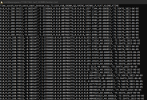Hi,
I am running WRF model simulation and not sure that which namelist configuration is actually affecting the bottom_top dimension in wrf output?

For the same lat,long I am getting output at 32 different levels. But I do not need 32 levels for a single lat/long(only 2-3 would be enough for me).
Is there a way to reduce these levels in the output?
Also by reducing the levels will it affect the running time of the model?
namelist.wps -
I am running WRF model simulation and not sure that which namelist configuration is actually affecting the bottom_top dimension in wrf output?

For the same lat,long I am getting output at 32 different levels. But I do not need 32 levels for a single lat/long(only 2-3 would be enough for me).
Is there a way to reduce these levels in the output?
Also by reducing the levels will it affect the running time of the model?
namelist.wps -
namelist.input -&share
nocolons = .true.
max_dom = 2
start_date = '2023-06-05_00:00:00', '2023-06-05_00:00:00'
end_date = '2023-06-05_01:00:00', '2023-06-05_01:00:00'
interval_seconds = 3600
/
&geogrid
parent_id = 1, 1
parent_grid_ratio = 1, 2
i_parent_start = 1, 11
j_parent_start = 1, 11
e_we = 31, 31
e_sn = 31, 31
map_proj = 'lambert'
dx = 6000
dy = 6000
ref_lon = -74.50
ref_lat = 41.50
geog_data_res = 'lowres', 'lowres'
geog_data_path = '/wrf_32/DATA/geog/WPS_GEOG_LOW_RES'
truelat1 = 30.0
truelat2 = 60.0
stand_lon = -74.50
/
&ungrib
out_format = 'WPS',
prefix = 'FILE',
pmin = 1.
/
&metgrid
fg_name = 'FILE'
/
&time_control
start_year = 2023, 2023
start_month = 6, 6
start_day = 05, 05
start_hour = 00, 00
end_year = 2023, 2023
end_month = 6, 6
end_day = 05, 05
end_hour = 01, 01
interval_seconds = 3600
input_from_file = .true., .true.
history_interval = 60, 60
frames_per_outfile = 100, 100
restart = .false.
restart_interval = 7200
io_form_history = 2
io_form_restart = 2
io_form_input = 2
io_form_boundary = 2
start_minute = 0, 0
start_second = 0, 0
end_minute = 0, 0
end_second = 0, 0
nocolons = .true.
/
&domains
time_step = 36
time_step_fract_num = 0
time_step_fract_den = 1
max_dom = 2
e_we = 31, 31
e_sn = 31, 31
e_vert = 33, 33
num_metgrid_levels = 42
num_metgrid_soil_levels = 4
dx = 6000.0,
dy = 6000.0,
grid_id = 1, 2
parent_id = 1, 1
i_parent_start = 1, 11
j_parent_start = 1, 11
parent_grid_ratio = 1, 2
parent_time_step_ratio = 1, 2
feedback = 1
smooth_option = 0
sfcp_to_sfcp = .true.
/
&physics
physics_suite = 'CONUS'
mp_physics = 0, 0
cu_physics = 0, 0
radt = 9, 3
bldt = 0, 0
cudt = 0, 0
icloud = 0
num_land_cat = 21
sf_urban_physics = 1, 1
/
&dynamics
hybrid_opt = 2
w_damping = 0
diff_opt = 1, 1
km_opt = 4, 4
diff_6th_opt = 0, 0
diff_6th_factor = 0.12, 0.12
base_temp = 290.0
damp_opt = 3
zdamp = 5000.0, 5000.0
dampcoef = 0.2, 0.2
khdif = 0, 0
kvdif = 0, 0
/
&bdy_control
spec_bdy_width = 5
specified = .true.
/
&namelist_quilt
/
